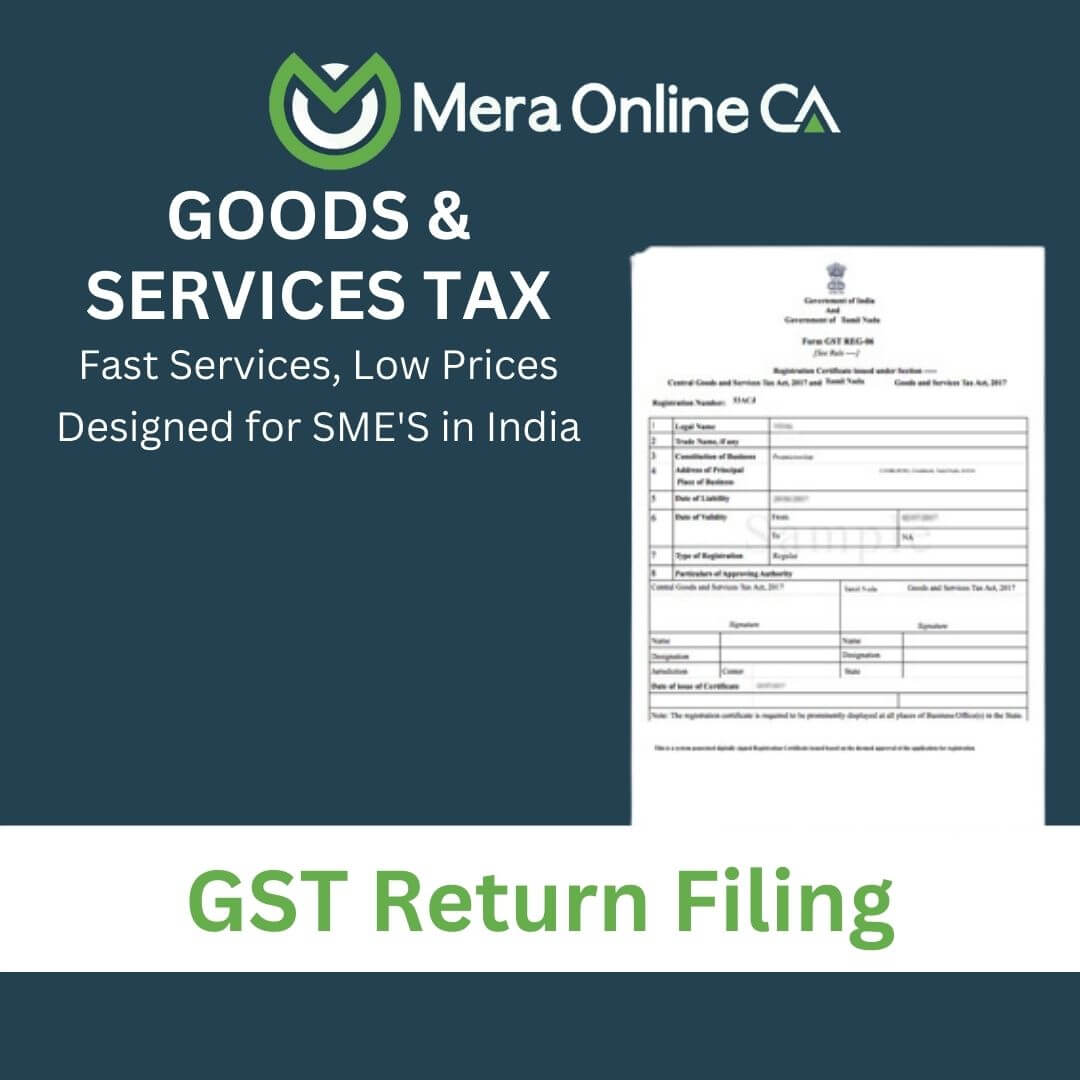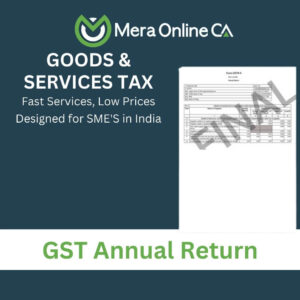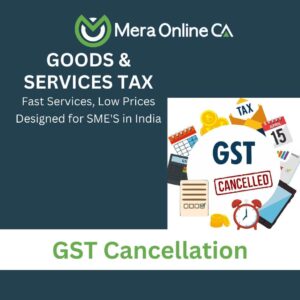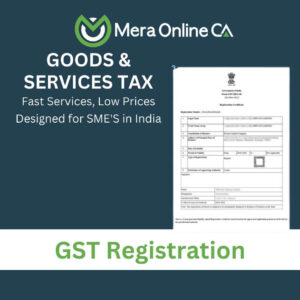GST Return Filing
What is GST return filing?
Businesses that are registered under GST have to file the GST returns monthly, quarterly, and annually based on the business. Here it is necessary to provide the details of the sales or purchases of the goods and services along with the tax that is collected and paid. Implementation of a comprehensive Income Tax System like GST in India has ensured that taxpayer services such as registration, returns, and compliance are in range and perfectly aligned.
An individual taxpayer filing the GST returns has to file 4 forms for filing the GST returns such as the returns for the supplies, returns for the purchases made, monthly returns, and the annual returns.
GST return filing in India is mandatory for all the entities that have a valid GST registration irrespective of the business activity or the sales or the profitability during the period of filing the returns. Hence, even a dormant business that has a valid GST registration must file the GST returns.
GST return is a document that contains the details of all the income or the expenses that a taxpayer is required to file with the tax administrative authorities.
Eligibility Criteria
Who should file the GST returns?
GST Return filing in India is to be done by the following:
Types of GST Registration
What are the different types of GST registration in India?
| GSTR 1 | Details of the outward supplies of the taxable goods and or services | Monthly |
| Quarterly (If opted under the QRMP scheme) |
| GSTR 3B | Simple returns in which a summary of the outward supplies along with the input tax credit that is declared and the payment of the tax is affected by the taxpayer. | Monthly |
| Quarterly |
| CMP 08 | Statement cum challan to make a tax payment by a taxpayer registered under the composition scheme under Section 10 of the CGST Act. | Quarterly |
| GSTR 4 | Returns to be filed by the taxpayer that is registered under the composition scheme under Section 10 of the CGST Act | Annually |
| GSTR 5 | Returns to be filed by a Non-resident taxable person | Monthly |
| GSTR 6 | To be filed by the input service distributor to distribute the eligible input tax credit | Monthly |
| GSTR 7 | Is filed by the government authorities | Monthly |
| GSTR 8 | Details of supplies that are affected through the e-commerce operators and the amount of tax that is collected at the source by them. | Monthly |
| GSTR 9 | Annual return for a normal taxpayer | Annually |
| GSTR 9C | Certified reconciliation statement | Annually |
| GSTR 10 | Is filed by the taxpayer whose GST registration is canceled | Once the GST registration is canceled or surrendered |
| GSTR 11 | Details of the inward supplies are furnished by a person who has UIN and also claims a refund. | Monthly |
Due dates for filing the GST returns
What are the due dates for filing GST returns?
GSTR 1: The 11th of Subsequent of that month
GSTR 3B: The 20th of that subsequent month
CMP 08: 18th of the month succeeding the quarter of the specific fiscal year.
GSTR 4: 18th of the month succeeding the quarter.
GSTR 5: 20th of the subsequent month
GSTR 6: 13th of the subsequent month
GSTR 7: 10th of the subsequent month
GSTR 8: 10th of the subsequent month
GSTR 9: 31st December of the Fiscal year.
GSTR 10: Within 3 months of the date of cancellation or the date of cancellation order whichever is earlier.
GSTR 11: 28th of the month that is following the month for which the statement was filed.
GST Return Filing Process
How to file the GST returns?
Mera Online CA is a leading business service platform in India that offers end-to-end GST services. We have helped thousands of business owners to get GST registration, as well as file GST, returns.
- When GST return filing is outsourced to Mera Online CA a dedicated GST advisor is assigned to the business.
- This dedicated advisor would reach out to you every month and collect the necessary information, prepare the GST returns and help in filing the GST returns.
Why Mera Online CA for Filing GST returns?
Filing GST returns takes around 1 to 3 working days subject to the availability of the government portal and the submission of documents by the client.
Return Filing under the Composition Scheme
All persons registered under the Composition Scheme are required to pay taxes using CMP-08 every quarter and GSTR 4 to be filled annually through the GST Common Portal or a GST Facilitation Centre. GST return for those enrolled under Composition Scheme is due on the 18th of the month, succeeding a quarter. Hence, the GST return for the composition scheme would be due on April 18th, July 18th, October 18th, and January 18th. The GST return filed by a Composition Scheme supplier must include details of:
If a registered person opted to pay tax under composition scheme from the beginning of a financial year, then the taxpayer must file monthly GST returns on the 10th, 15th, and 20th of each month and monthly returns till the due date of furnishing the return for September of the succeeding financial year or furnishing of annual return of the preceding financial year, whichever is earlier. Hence, even if a taxable person under GST opted for a composition scheme from April onwards, the taxpayer must continue filing monthly GST returns until September.
Benefits of choosing Mera Online CA for the GST returns
Dedicated GST Advisor
A relationship manager with experience in the sector that you operate in will guide you through the process of GST registration and filings. They will help with specific tasks such as uploading invoices and also ensure that your filing is taken care of on time.
Reminder to file GST returns
Our platform ensures that you get timely reminders well in advance of the deadline beyond which penalty will be applicable. In addition to this, your GST advisor will also remind you periodically so that no deadlines are missed.
Monthly GST Status reports
Monthly reports detailing the status of GST return filing including GSTR- 3B and the way forward will be shared with the clients by the GST advisors.
GST returns by LEDGERS
GST returns are prepared by LEDGERS- the GST software so that it is error-free and filed on time without hassles.
GSTR- 1 and GSTR- 3B filing
GSTR-1 is a quarterly return that should be filed by every business. Turnover determines the due dates for GSTR- 1. Business with sales up to Rs. 1.5 Crore can file their quarterly returns.
Input Tax Credit Reconciliation
Businesses will be enabled to benefit from the input tax reconciliation mechanism provided by the government to achieve neutrality in the incidence of tax and ensure that such input tax element does not enter into the cost of production or cost of supply of goods and services.
Standard accounting and cloud records
All of your financial transactions and invoices will be recorded in LEDGERS by accountants so that the filing of all your returns including ITR, TDS, and GST is seamless and cost-effective.
LEDGERS GST Software
In addition to the GST advisor support, LEDGERS GST Software will be provided to the client for GST invoicing, payments, returns filing and accounting.
Some of the features of LEDGERS are:
Penalties
What are the penalties, late fees, and interest rates?
If there are any offenses committed then a penalty has to be paid under GST
Late filing
Late filing of the GST returns can attract a penalty called a late fee. And according to the Goods and Service Tax can attract a penalty which is Rs. 100 under CGST and Rs.100 under SGST that accounts for Rs.200 a day.
With the late fee, an interest of 18% has to be paid per annum. It is calculated on the tax to be paid.
Non-compliance
In case if the taxpayer is not filing the GST returns then the subsequent returns cannot be filed. Hence, to avoid heavy fines and penalties it is better to file the GST returns on time as it will lead to a cascading effect.
For 21 offenses with no intention of fraud or tax evasion
An offender who is not paying taxes or is making short payments must pay a penalty of 10% of the amount of tax due subject to a minimum of Rs.10,000.
For 21 offenses with the intention of fraud or tax evasion
An offender is subject to a penalty amount of tax evasion or short deducted.
Even in case if there is no business the taxpayer is required to file the Nil GST returns.
Outsource GST Compliance
Outsource your GST compliance to Mera Online CA to ease your compliance burden and focus your efforts on growing your business. With Mera Online CA, your GST compliance will be maintained on the LEDGERS GST platform, providing you access to live business data – anywhere, anytime. LEDGERS can also seamlessly sync and work with other online and offline applications you regularly use.
How will the service be delivered?
You will have a dedicated GST Accountant assigned to your business. Each month, the Accountant will collect all the information and file your GST returns.
How will the information or documents be collected?
You can send us the information through email in any platform or upload the information. We also accept soft copy of invoices and purchase data.
What returns will be filed?
We will file GSTR-3B return and GSTR-1 return for regular taxpayers registered under GST. For composition dealers we will assist in filing GSTR-4 return.
What will be my responsibility?
You will only be responsible for providing the information or documents required to prepare your GST return. Once we have prepared the filing, you can verify the calculation and confirm the filing.
Will you provide support for GST input tax credit?
Yes, we will provide you input tax credit reconciliation. You can use the same to verify the input tax credit receivable for your business.
Will you provide support for GST refund?
Yes, for clients who subscribe to our GST return filing annual package, we provide support for GST refund processing.
Will you provide support for GST payment?
Yes, for clients who subscribe to our GST return filing package, we provide support for GST payment challan generation.
Find GST Filing Return Due Dates for GSTR 1 to GSTR 11
GSTR-1 (Monthly)
Monthly GSTR 1 returns must be filed by taxpayers having a turnover of more than Rs.1.5 crores on 11th of every month.
GSTR-1 (Quarterly)
Quarterly returns must be filed by taxpayers having a turnover of less than Rs.1.5 crores on 13th of every quarter.
CMP-08- Quarterly-Composition Scheme
CMP-08 must be filed by taxpayers registered under the GST composition scheme having a turnover of upto Rs.1 Crore on 18th of every quarter.
GSTR-4- Annual-Composition scheme
The due date for filing GSTR 4 is 30th of the month succeeding the financial year for which the composite taxpayer is filing the annual return.
GSTR-9- Annual returns
Annual GST return filing for the financial year is due on 31st December. This is mandatory for all entities.
GSTR-1 Return
GSTR 1 or return of outward supplies must be filed by all taxpayers having regular GST registration. The due date for filing GSTR 1 return is the 10th of every month. For July, September and October, the GST return due dates are different from the normal schedule.
GSTR-2 Return
GSTR2 or return of inward supplies must be filed by all taxpayers having regular GST registration. The due date for filing GSTR 2 return is the 15th of every month. For July, September and October, GSTR2 return due dates are different from the normal schedule.
GSTR-3 Return
GSTR3 or monthly GST return must be filed by a taxpayer after filing GSTR1 and GSTR2 return. GSTR3 is due on the 20th of every month. For July, September and October, GSTR2 return due dates are different from the normal schedule.
GSTR-4 Return
GSTR4 return must be filed by taxpayer registered under the GST composition scheme. GSTR4 is a quarterly return that is due on the 18th of October, January, April and July.
GSTR-5 Return
GSTR5 return must be filed by persons registered under GST as a non-resident taxable person. GSTR5 is due on the 20th of every month.
GSTR-6 Return
GSTR6 return must be filed by persons registered under GST as an input service distributor. GSTR6 return is due on the 13th of every month.
GSTR-7 Return
GSTR7 return must be filed by all taxpayers required to deduct tax at source (GST TDS). Under GST, only certain government agencies are required to deduct tax at source after obtaining registration. Hence, GSTR7 is due only for those entities having GST TDS registration. GSTR7 is due on the 10th of every month.
GSTR-8 Return
GSTR8 return must be filed by taxpayers required to collect tax at source. E-commerce operators are required to collect tax at source. Hence, any persons operating an e-commerce venture must register for TCS, collect tax at source and file GSTR8 return before the 10th of every month.
GSTR-9 Return
GSTR9 is GST annual return that must be filed by all regular taxpayers. Details submitted with GSTR9 must be audited if the entity has a turnover of more than Rs.2 crores. GSTR9 is due on or before the 31st of December.
GSTR-10 Return
GSTR10 return must be filed by any person whose GST registration has been cancelled or surrendered. GSTR10 must be filed within 3 months of the date of cancellation order or surrender.
GSTR-11 Return
GSTR11 must be filed by persons having Unique Identity Number. GST Unique Identity Number is allotted to Consulate, Embassies and UN Bodies for claiming refund on inward supplies.
Staggered Return of GSTR-3B
| Turnover | Deadline for Dec 2020 | Applicable to |
|---|---|---|
| More than 5 crores | 20th of Every month | All the states and UTs |
| Less than 5 crores | 22nd of Every month for Group A States |
Chhattisgarh, Madhya Pradesh, Gujarat, Daman and Diu, Dadra and Nagar Haveli, Maharashtra, Karnataka, Goa, Lakshadweep, Kerala, Tamil Nadu, Puducherry, Andaman and Nicobar Islands, Telangana and Andhra Pradesh |
| Less than 5 crores | 24th of Every month for Group B States |
Jammu and Kashmir, Laddakh, Himachal Pradesh, Punjab, Chandigarh, Uttarakhand, Haryana, Delhi, Rajasthan, Uttar Pradesh, Bihar, Sikkim, Arunachal Pradesh, Nagaland, Manipur, Mizoram, Tripura, Meghalaya, Assam, West Bengal, Jharkhand and Odisha |






1. Who should file GST returns?
16 November 2021
Under GST, every person or entity registered under GST would be required to file a GST return for the prescribed period. Even those entities having a GST registration but no activity would be required to file a GST Nil Return to stay compliant with GST regulations.
2. How often would I have to file GST returns?
08 December 2021
Regular taxpayers would have to file GSTR-1 (details of outward supplies), GSTR-2 (details of inward supplied) and GSTR-3 (monthly return). GSTR-1 would be due on the 10th of each month, GSTR-2 would be due on the 15th of each month and GSTR-3 would be due on the 20th of each month. Compounding taxpayers must file GSTR-4 every quarter, on 18th of the month next to the quarter. In addition to the monthly or quarterly returns, an annual return must be filed by all persons or entities registered under GST. The due date for filing of annual GST return would be 31st of December following the end of financial year. In case of assesses having to complying with auditing requirements, the GST reconciliation statement must be duly certified by a Chartered Accountant.
3. How to file GST returns?
08 December 2021
GST Returns must be filed online. There would also be a facility to prepare the returns offline and upload the same into an online portal.
4. Can the GST return be revised?
08 December 2021
There would be no procedure or revision of a GST Return. All unreported invoices of the previous tax period must be included in the return for the current month and interest if any would be applicable.
5. What is the penalty for not filing GST returns?
08 December 2021
All GST Return non-filers will be tracked by the GST Department and a list of GST return defaulters will be provided to the respective GST authorities for follow-up and enforcement action. The GST law would also include the imposition of an automatic late fee for GST Return non-filers and late filers.
6. Who should file GSTR 1 Return?
08 December 2021
Under GST, all taxpayers, other than an input service distributor, a non-resident taxable person, a casual taxable person, and a person paying tax under the GST composition scheme are required to file a GSTR1 return. Know more about GSTR1 return filing.
7. How to file GSTR 1 Return?
08 December 2021
GSTR1 return can be filed online in the GST portal. You can also file GSTR1 return using LEDGERS GST Software, to file GSTR1 return using LEDGERS, create an account, update details of sales made during a month and click on upload GST return to file.
8. What is the time limit for filing GSTR 1 return?
16 November 2021
The due date for filing GSTR1 return is usually the 10th of every month. However, for the month of July 2017, the due date for filing GSTR1 return is 10th of October. The due date for filing all other GSTR1 return is yet to be announced by the GST Council.
9. What information is required to be filed in GSTR 1?
08 December 2021
In GSTR1 return, the following information is filed by the taxpayer: Basic details of the taxpayer with GSTIN. Period to which the Return pertains. Invoice level information B2B invoices B2C invoices over Rs.2.5 lakhs in value B2C invoices less than Rs.2.5 lakhs in value Export invoices Summary of Documents Issued HSN Code wise summary of sales
10. What is the meaning of details of outward supplies?
08 December 2021
Under GST, the expression “details of outward supplies” means information pertaining to sales transactions in a month like invoices issued, debit notes, credit notes, and revised invoices.
11. Can GSTR 1 Return be rectified?
08 December 2021
Yes, any registered taxable person, who has filed a GSTR1 return can rectify the return if there is a discovery of any error or omission. The rectification can be filed in the tax period in which such error or omission is noticed. In case there is any short payment of tax, the payment of tax and interest can also be made during the period of discovery of error or omission.
12. What is the time limit for GST return rectification?
08 December 2021
GST return can be rectified by a taxpayer until the month of September following the end of the financial year to which the details pertain or furnishing of the relevant annual return, whichever is earlier.
13. What invoices should be uploaded to the GST portal?
08 December 2021
For all B2B supplies (whether inter-State or intra-State), invoice level details like customer GSTIN, the item-wise value of supply, amount of tax applicable, place of supply, date of invoice and invoice number should be uploaded. For all B2C supplies (including non-registered Government entities, Consumer/person dealing in exempted/NIL rated/non-GST goods or services), the suppliers should upload invoice level details similar to B2B invoices, when the value of supply is more than Rs.2.5 lakhs. For invoices with a value of less than Rs.2.5 lakhs, State-wise summary of supply statement should be filed. The address of the buyer has to be mandatorily reflected in every invoice having a value of Rs.50,000/- or more. Procedure for uploading invoice to GST portal.
14. How to mention HSN Code in the Invoice?
08 December 2021
HSN code (4-digit) for Goods and Services Accounting Codes (SAC) for Services must be compulsorily mentioned by all taxpayers with turnover in the preceding financial year above Rs. 5 Crore (For the first year of operations of GST, self-declaration of turnover of previous financial year will be taken as the basis as all India turnover data will not be available in the first year. From the 2nd year onwards, turnover of previous financial year under GST will be used for satisfying this condition. For taxpayers with turnover between Rs. 1.5 Crores and Rs. 5 Crores in the preceding financial year, HSN codes may be specified only at 2-digit chapter level as an optional exercise to start with. From second year of GST operations, mentioning 2-digit chapter level HSN Code will be mandatory for all taxpayers with turnover in previous financial year between Rs. 1.5 Crores and Rs. 5.0 Crores. All taxpayers, irrespective of his turnover, can use HSN code at 6-digit or 8-digit level if desired. To start with, compounding dealers may not be required to specify HSN at 2 digit level also. HSN Codes at 8-digit level and Accounting Codes for services will be mandatory in case of exports and imports. The taxpayers who have turnover below the limit of Rs. 1.5 Crore will have to mention the description of goods/service, as the case may be, wherever applicable. In order to differentiate between the HSN code and the Service Accounting Code (SAC), goods will be denoted by G and services will be denoted by S. Click here to find HSN code and GST rate for all goods and services.